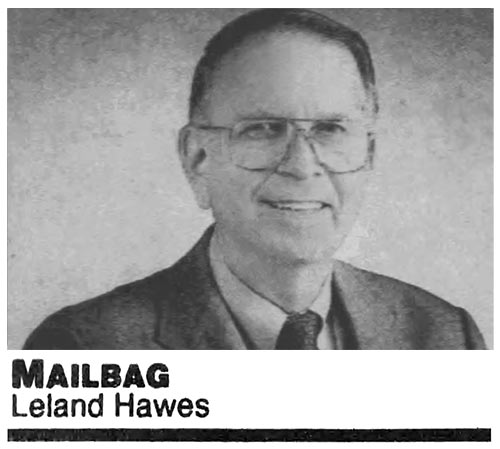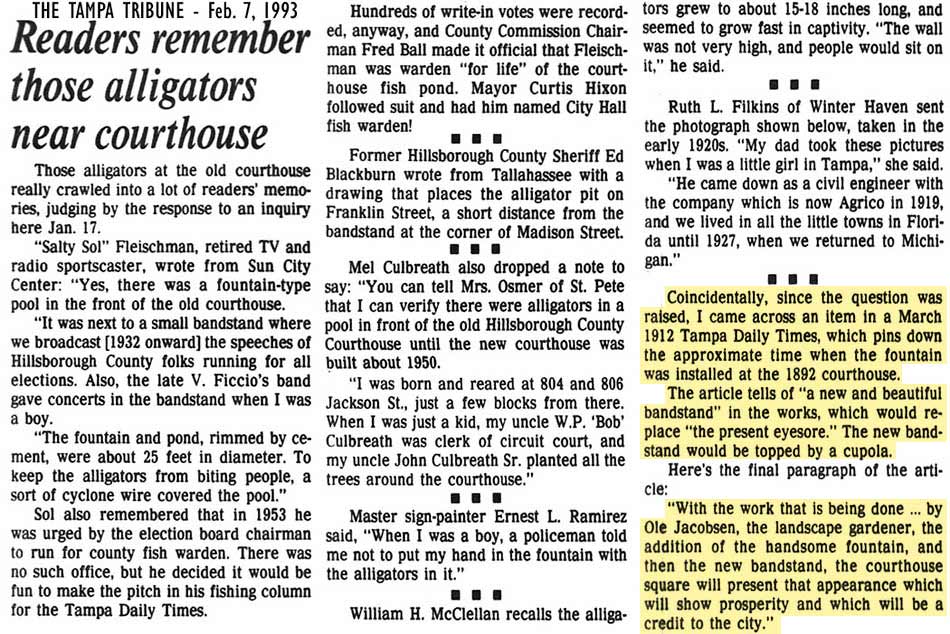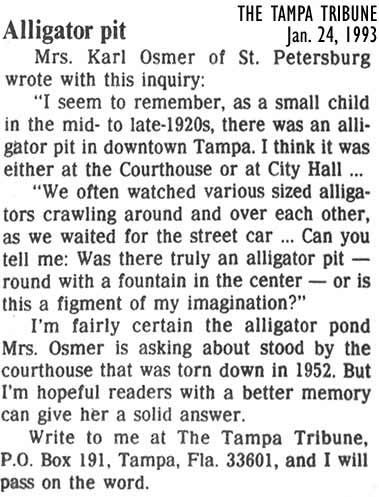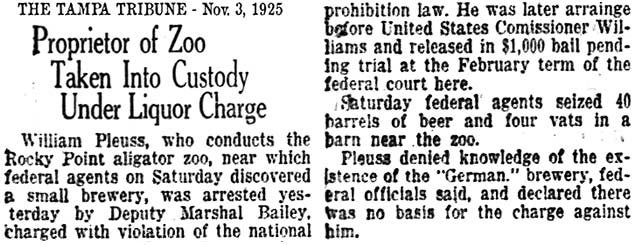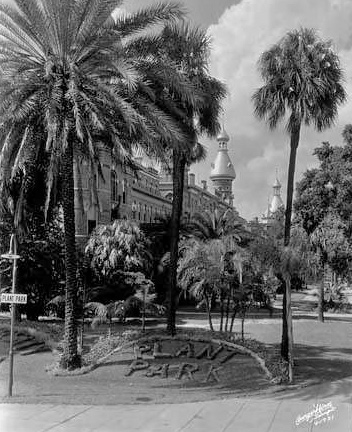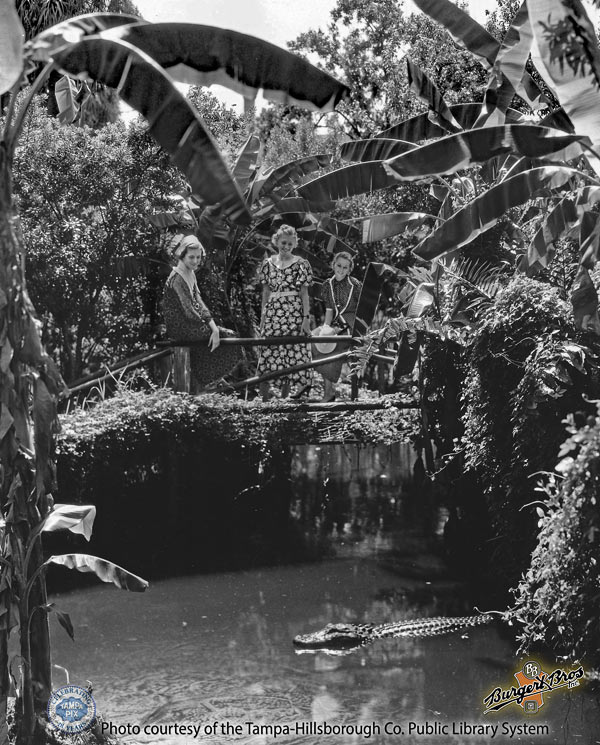|
BEFORE PLANT PARK: COURTHOUSE SQUARE FOUNTAIN POOL - GATORS,
FROGS, FISH AND TURTLES
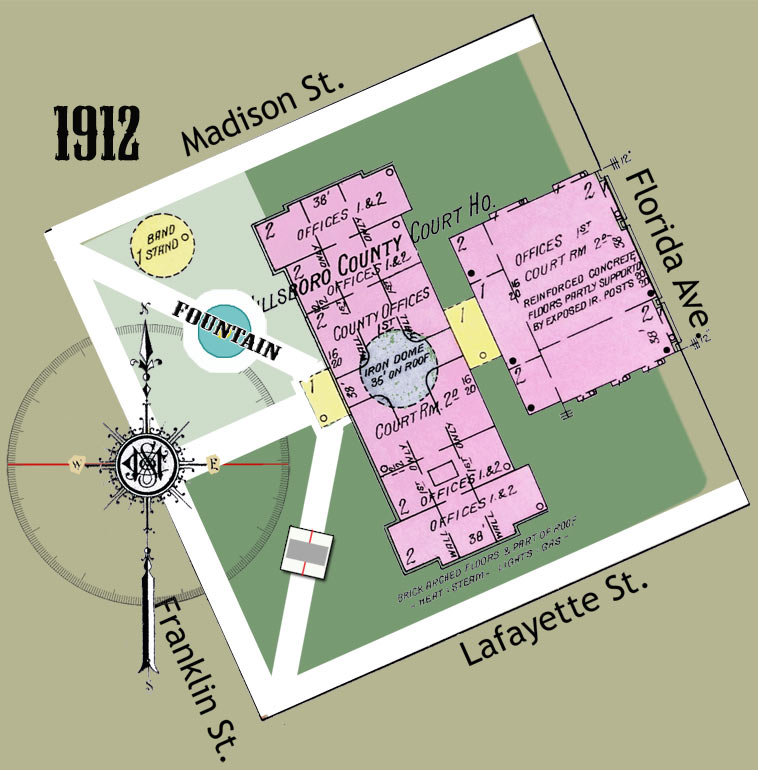 The beginnings of a
conveniently located zoo near the center of town began in 1912 when a
bronze fountain and surrounding circular pool was built on Courthouse Square.
The pool was approximately twenty-five feet in diameter and was located
on the courthouse lawn nearest the
intersection of Madison St. and Franklin St., between the bandstand and
courthouse entrance. The beginnings of a
conveniently located zoo near the center of town began in 1912 when a
bronze fountain and surrounding circular pool was built on Courthouse Square.
The pool was approximately twenty-five feet in diameter and was located
on the courthouse lawn nearest the
intersection of Madison St. and Franklin St., between the bandstand and
courthouse entrance.
After the old, original
wooden bandstand was replaced by a reinforced concrete one, the entire
quadrant of the lawn on that corner was paved over .
The fountain had two
levels, shaped like dishes; a larger lower level and a smaller upper
level where a statue of a boy stood at the
top, holding over his head an open umbrella from where the water sprouted. Over the
years, the basin became a home to various fish, alligators, and turtles,
and whatever else anyone felt like abandoning in there, like frogs,
food scraps, and litter. It was quite a popular gathering place, with
the various reptiles and fish attracting quite a bit of attention.
The gators were being fed
regularly by the courthouse custodian, in fact they were overfed and quickly grew fat. Feeding
time was an event that drew in crowds, and it is evident that Tampa
sorely needed a zoo, and that it would draw many visitors if located in
or around downtown. The collection not only captured the attention
of onlookers, it was a subject often written about in the papers,
usually in a humorous style.
From time to time, the
larger gators were removed and sent to the Sulphur Springs alligator
farm and in the later years, to Plant Park.
THE
FOUNTAIN ZOO AT COURTHOUSE SQUARE
Click the dates to see the
articles.
|
Aug. 3, 1911 |
WILL HAVE
SIDEWALKS |
The first mention of an ornamental fountain
for courthouse square was at an Aug. 1, 1911 county commission
meeting where a bid was accepted from Concrete Construction
Company to build diagonal sidewalks on the courthouse
lawn (where the Confederate memorial and bandstand were) from each corner of the
yard to the courthouse entrance. The plans also called for
a fountain. |
|
Nov. 11, 1911 |
COMMITTEE
WILL LOOK AT FOUNTAIN DESIGNS - Planned to get handsome one
for court house yard - Report next meeting. |
A county commissioners committee
consisting of Chairman W. A. West, W.W. Whitehurst, P.H.
Collins, and F.J. DeVane examined various fountain designs and
would report on their recommendations as to what kind should be
purchased and how much to spend. "It is desired to get as
ornamental a fountain as possible consistent with the economy." |
|
Dec. 6, 1911 |
County
Commissioners Meeting report on water main. |
Chairman West reported that a
larger water main would need to be laid to accommodate the
fountain which the board selected. West stated he had been
informed that some time prior to his being on the board, a
contract was made with D. W. Shea to lay a two-inch pipe for
which he was paid, but he laid a one-inch pipe instead.
West also stated that he hired a man to paint the courthouse
dome for $100 and the work be done at once. |
|
Dec. 7,
1911 |
FOUNTAIN
IS ORDERED |
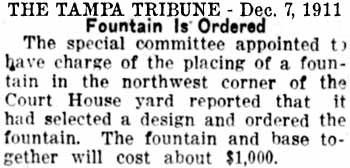 A
design for the fountain was selected and ordered and together with the base
they would
cost about $1,000. A
design for the fountain was selected and ordered and together with the base
they would
cost about $1,000. |
|
Jan. 20, 1912 |
SPLASHING FOUNTAIN FOR COURTHOUSE SQUARE -
Where music of
waters will mingle with perfume of flowers, replacing sordid
brown of earth and footprints. |
Construction by the Tampa
Monumental Works will begin in a few days on the fountain
near the old bandstand. Sidewalks have already been built
and and expert landscape gardener was to be hired to complete
the plants and flowers. Afterward, the groundskeeper Ole
Jacobsen would maintain the grounds. A
beautiful Bermuda grass lawn was laid artistically arranged with
flower beds and many improvements by Jacobsen, whose small
plants were just beginning to sprout. When grown, the
plants will spell out "HILLSBOROUGH COUNTY." A
more detailed description of the landscaping is given, and
mention of the old bandstand being replaced soon by "one of a
more substantial nature." |
|
Feb. 8, 1912 |
COURTHOUSE
FOUNTAIN TINKLES MERRILY AWAY - Other improvements about the
County's Building. |
The water to the fountain was
turned on yesterday afternoon and attracted much attention.
The handsome piece of work was built by the Tampa Monumental
Works under supervision of J. W. Lester. The surrounding
sidewalk has been made wider and other improvements made.
The bandstand was an eyesore for many years and would soon be
replaced by a handsome brick one. Jacobsen, the gardener,
has submitted plans for more improvements of the grounds. |
|
Mar. 12, 1912 |
COUNTY OWNS SOME
LAKE TROUT NOW, They're at home in the fountain which graces
the courthouse square. |
Judge Gibson and W. F. Ferman went
fishing at Lake Butler when the judge decided to bring back some
trout for the courthouse fountain. They put several
samples in their minnow buckets, brought them safely back to
Tampa and slipped them into the fountain pool. |
|
Mar. 30, 1912 |
COUNTY'S FROG
RIDES BACK OF BIG TURTLE, Capering in pool at fountain.
Pete Allen's frog? |
The antics of a large frog and
a turtle placed in the pool overnight are described as a "royal
battle." The frog delighted in jumping on the turtle's
back and the turtle did not oblige the friendship.
One of the spectators was Pete Allen who used to own a frog
farm in Stemper (which is an area on the south side of what
became Lutz, near the "Apex.") Allen said it looked
like it was one of his frogs, but nobody claimed the turtle
because it was too ugly. Now there was a frog, a turtle, and
several fish drawing a crowd and providing them with
entertainment. A bystander said that since everyone was so
entertained, he was going to bring an alligator on Monday, "and
then there will be some fun." |
|
Apr. 15, 1912 |
COURTHOUSE
FOUNTAIN LITTERED WITH GARBAGE, Designed as ornament,
becoming an eyesore. |
The fountain has degenerated
from an ornament to an eyesore. It had only been
TWO MONTHS since it was built. This article
reveals that the fountain was made possible by the Tampa Civic
Association. The pool no longer sparkled, it was a
muddy green with bread, cabbage and cauliflower leaves floating
around which were placed there to feed the turtles and frog.
Added to the mix was a tin can and a glass liquor bottle.
The pool has taken on the look of "a mud hole in the rear of a
tenement." |
|
Jun. 22, 1912 |
New bandstand to be built. |
Thanks to the efforts of Maj.
Charles E. Wright, a new bandstand was to be built to replace
the old dilapidated original one. The new one would be
made of reinforced concrete and the lawn in the spaces between
the sidewalks in this quadrant of courthouse square would be
paved. This was because the lawn would be
trampled by crowds and thus look bad. |
|
Oct. 14, 1912 |
CONTRACT FOR NEW COURT HOUSE BAND STAND |
The contract to build the
new bandstand was awarded to D. J.
Anderson who would begin work next week and be done by Dec. 13.
The cost was to be a little more than $1,000. The very
ornamental stand would be entirely concrete with a red tile roof
and basement for storage. The stage would be slightly
higher than the old stand. The design was awarded to
Bonfoey & Elliott in a competition with other architects. |
|
Nov. 24, 1912 |
MUNICIPAL BAND
NOW USES NEW BANDSTAND, Further improvements to be made. |
The Tampa Municipal Band began
using the bandstand when it was nearly finished. It was said
that the structure was very decorative and added to the
attractiveness of the place. "In the basement will be
arranged cupboards in which music, musical instruments and the
uniforms of the bandsmen will be kept. One side of the
basement will be used by the gardener for storage of his tools."
It was expected to be a short time when the entire corner
surrounding the bandstand would be paved with cement and more
benches added, with some plots left for flower beds. |
Jul. 1, 1913
(Excerpt) |
C.O.D. PARCEL
POST INAUGURATED TODAY,
Box of gator eggs will be first
Tampa shipment - Saurian fruit goes to Indiana - Sunny Jim
Robinson presents city with new and handsome "lizard." |
R. W. Janes and Sunny Jim Robinson
went fishing near Fivay Junction. Jim got a bite that
seemed like a whale, but it turned out to be a two-foot long
gator. He tied it to a stake with a string.
Later, Janes found some gator eggs in a nest and knowing it was
the first day of COD parcel post service in Tampa, they came to
town with the gator in a sack and sent the eggs COD to Miss
Louise Janes in Mt. Vernon, Indiana. Jim thought it would
be funny to play practical jokes on local merchants with the
sacked gator. At the Court House Square pharmacy, he told
them he had a "pretty bunny" in the sack. He turned it
inside out and out dropped the gator on the floor, which
skittered toward the door to the shock of everyone there.
The soda jerk managed to intercept it before it got out.
"Other places on Franklin St. were visited, and in each, Sunny
Jim cleared the stores faster than a blast of dynamite would
have done it." The gator was finally given a new home
in the fountain at Court House Square, after a local
newsstand merchant had made a aluminum neck decoration for it.
Councilman Bartlett was present when the gator was put in the
fountain and said that if anyone removed the reptile from there,
he would "resign from his place among the City Dade forever." |
|
Jul 24, 1913 |
IMPROVING
NEGLECTED CORNER OF COURTYARD, Walks will be laid out,
Flower beds Planted |
SEVEN months have passed since the
completion of the new bandstand, and yet the much publicized
paving of the area had been neglected. Workmen finally
began the improvements on July 23, 1913, under instructions from
the County Commissioners. Enough cement paving would be
laid out to accommodate standing and sitting room for crowds to
gather, but sufficient ground would be reserved for flowers .
A unique "twin palm tree" was transplanted from its original
location on the Alafia river, which chairman J. L. Hackney found
and arranged to have moved. Visitors to the area were as
interested in the tree as they were the feeding of the gators. |
|
Aug. 18, 1913 |
PUBLIC SQUARE IS
AN ORNAMENT - Visitor comments on the change - What was once
an eyesore has been metamorphosed into a thing of beauty. |
A visitor spoke to a Tampa
Times reporter saying that courthouse square has been changed
into a "beauty spot from what once a disgrace to a progressive
city like Tampa." It used to give him a sorrowful feeling
to see the condition of the square, now it was a "pleasure to
gaze upon." The northwest quadrant of the square had been
complete paved in cement, no more lawn around the bandstand and
fountain. Flower beds had been laid out around the
perimeter. The fountain was described as containing "the
family of Florida's first settlers, a group of alligators"
which was quite an attraction to visitors who "do not think
they have 'done' Florida until they form a fairy intimate
acquaintance with an alligator.." The article goes
on to praise the county commissioners for their work in
restoring the square, including the "handsome statue to the
memory of Florida soldiers of the Confederacy."
See photos and a feature about this monument and history of this
courthouse here at TampaPix. |
|
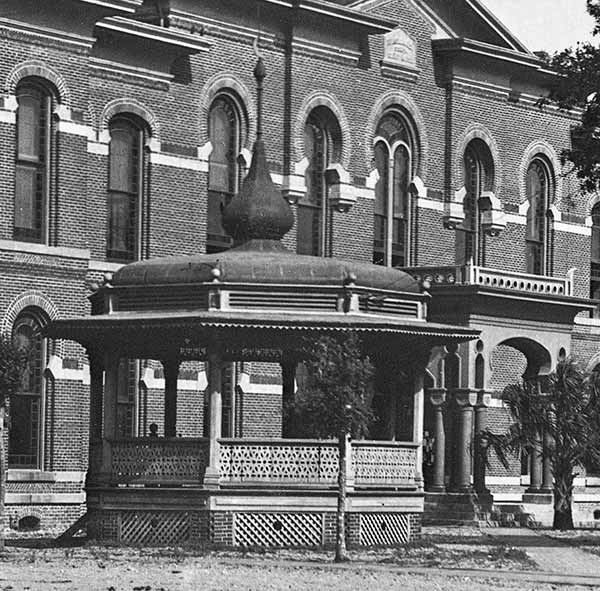 .jpg)
AT LEFT:
The original wooden bandstand in 1898.
AT RIGHT:
The 1912 bandstand seen in 1936. The fountain pool can be
seen at lower right.
Above Left: A cropped portion of much larger image courtesy
of Florida Memory, State Library & Archives of Fla.
Above Right: A cropped portion of much larger image
courtesy of the Burgert Bros. collection at Tampa-Hillsborough
Co. Public Library System |
|
Aug. 31, 1913 |
PLANT CITY GATOR
IS LATEST GUEST IN COURTHOUSE FOUNT - Friend sends Sheriff
Spencer a pet, other gators hid while "new boy" shows his shape
proudly. |
The Board of County Commissioners
just had one of the largest gators removed from the pool because
it was deemed dangerous, when Sheriff W. C. Spencer added one
that was two feet longer than any of the others left in the
pool. The gator was sent to him by a friend in Plant City.
Among the spectators admiring the new young stud was chairman of
the board of commissioners who had the largest gator removed
previously. "In due time it will be as fat at the others, the
landscape gardener there giving the gators raw meat every day
until they can hold no more." |
|
Feb. 15, 1914 |
FEEDING TIME FOR
GATORS ATTRACTION FOR VISITORS - Crowds watch daily on
courthouse square to watch Jacobsen parcel out the meat. |
For visitors from the North, no
event is more notable than the daily feeding of the gators in
the courthouse square fountain pool. Every day, "hundreds
gather around the fountain to was gardener Ole Jacobsen hand out
the hunks of meat..." Known to northern visitors as a
"mythical creature" the first thing they want to see when they
get here is an alligator, "alive, dead or stuffed." The
feeding time attracted more attention than most any other free
show in Tampa. When Jacobsen makes his appearance at
about 4 p.m., the crowd usually makes a rush for the fountain. |
|
Apr. 6, 1917 |
RUBE DOES NOT
SEE WHY THE LAW SHOULDN'T PROTECT GATORS, Takes pleasure in
helping several escape, police interfere. |
A veteran Sarasota newspaper
editor, Rube Allyn, sees no reason or law that allows gators to be
confined, nor any law preventing him from freeing them from
their captivity. He believes alligators have "certain
inalienable rights such as life, liberty, etc (you know, that
thing.) Upon lifting them by the tail and letting them loose on
the square, the gator "produced a profound sensation among the
spectators, many of whom were badly frightened as the clumsy
creatures charged into the crowd." The liberator also said
"they are being overfed, so badly that it is injurious to their
health." He went on to say that there are scores of poor soldier
boys just having returned from the border and don't have enough
to even buy a meal, and "this is not just." When one of
the spectators could not locate the groundskeeper, he called the
police. Officer Hill arrived and informed Mr. Allyn that
"he must desist in his interference with the natural history
exhibit." |
|
WHO WAS OLE JACOBSEN?
According to his censuses in
Tampa, as well as other sources, Ole Jacobsen was born to
Danish parents in Denmark in May 1852. He was married to
Kristine, a native of Denmark, around 1884-85 before leaving
Denmark in 1891. They were listed as "steerage class"
passengers #36 & #37 on the S. S. Hekla and boarded the ship in
Copenhagen, arriving at the Port of NY on Feb. 11, 1891.
Ole was 38, Kristine was 35. Ole's occupation was
"Gardener" and their ultimate destination is somewhat illegible.
The city wasn't Chicago,
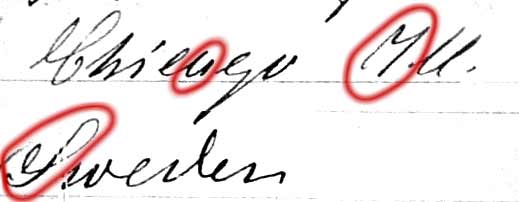 as
there are other instances of "Chicago" written on the manifest
and they are very different. The handwriting sample at
right shows the writer consistently makes a capital "I" in
Illinois. The lower case "a" is almost always open at the
top, making it look like a "u." The capital "S" always
looks like an "L" and appears many times in "Sweden."
Compare to the record below and their destination appears to have been Sabula, Iowa, a
town located on an island in the Mississippi River between
Illinois and Iowa, about 100 mi. west of Chicago. as
there are other instances of "Chicago" written on the manifest
and they are very different. The handwriting sample at
right shows the writer consistently makes a capital "I" in
Illinois. The lower case "a" is almost always open at the
top, making it look like a "u." The capital "S" always
looks like an "L" and appears many times in "Sweden."
Compare to the record below and their destination appears to have been Sabula, Iowa, a
town located on an island in the Mississippi River between
Illinois and Iowa, about 100 mi. west of Chicago.
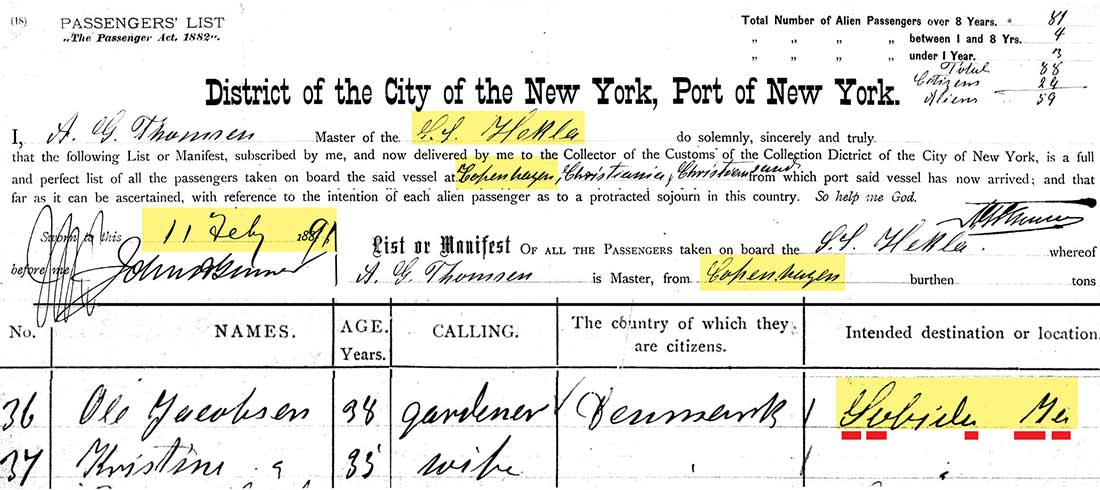
|
The first mention of
Ole Jacobsen found in the local papers is this
"position wanted" ad he placed on Aug. 18, 1909. |
|
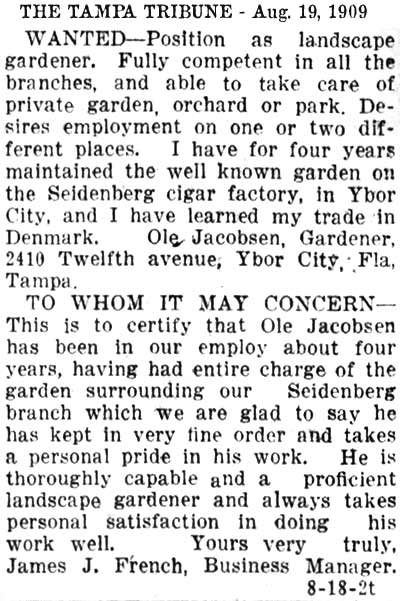 |
According
to his obituary, "Once, in his native town, he decorated the
city for a visit of the King of England and the Danish king and
queen. He came to the U.S. to do landscape work at the
Chicago World's Fair, which was held in 1893. The event
was officially billed as "World's
Fair: Columbian Exposition." He and Kristine came to
Tampa "four years later" and for ten years Ole was the custodian
of the courthouse square which he beautified.
An Oct. 5, 1913 Tribune article
"JACOBSON
GETS BADGE, Star As Large As a Man's Hand, Pinned on Gardener by
Sheriff" describes how he was presented with a "handsome
nickel-plated badge in the form of a star" by Sheriff W. C.
Spencer. Intended to be visible at a distance, it afforded
him authority to patrol the courthouse grounds and keep people
off the lawn. Also, to "help frighten away some of the
chronic loafers who sun themselves every day on the courthouse
benches." The article ends with "If the star doesn't do
the business, Jacobson has a fist that will. He is as
familiar with uppercuts and solar plexus blows as he is with
Bermuda grass and geraniums."
June 6, 1917 -
RED CROSS TENT MUST KEEP OFF THE GRASS - Commissioners
had several weeks earlier given the Red Cross permission to
erect a tent on the paved portion of the square, so as not to
damage the lawn, as recommended by Ole Jacobsen. They were
to notify Commissioner Milton H. Mabry Jr. when they began, and
they did neither. When they started the tent on the lawn,
Jacobsen put a stop to it. The matter was brought before
the board and voted on in support of Jacobsen's actions.
In June of 1919, Jacobsen asked
the Board of County Commissioners for a wage increase of his $85
per month salary. A
Jun. 7, 1919 Tribune article about the commissioners'
meeting of June 6, says "The board offered to add $5 on his pay,
but Oleson indignantly declined, saying that if the board
couldn't do any better than that he would quit on July 1."
The board decided to let him quit at once. After that,
several members said they had intended to increase his pay later
on when they were not so short of funds, but that Jacobsen had
been taking on outside work and devoting only part of his time
to the courthouse square. Also, there had been complaints
about his gruffness to persons about the place. (Gruffness
probably inspired by the article printed on Oct. 13, 1913
"Jacobsen gets badge" which appeared to encourage physical
violence.)
A Feb. 27, 1920 Times article
about baseball in Tampa says that the diamond at Plant field
will be ready for the Senators. "Ole Jacobsen, the
courthouse gardener, is seeing that the grass on the infield is
coming along and taking it all in all, the Senators will find it
fast, a firm sod, and better than they expected."
|
|
Jun. 29, 1921 |
PEACEMAKER KEPT BUSY WITH DOMESTIC PROBLEMS OF COURTHOUSE
FOUNTAIN |
J. H. Knight, now the courthouse
groundskeeper, tries to keep peace and harmony in the pool where
the kindly interest of Tampans continue capture wild things with
which to stock the courthouse square fountain. There are
now alligators and turtles, salt & fresh-water, of varying
sizes. Without regard to Knight's problems, a Tampan
had contributed a six-foot long alligator who devoured two of
the smaller ones before it could be sent to the alligator farm
at Sulphur Springs. The supply of gators grew so quickly
that five of the largest ones had already been sent to the farm
that year. Among the turtles were a "Haw Bill" sea
turtle without claws, a "Diamond back" sea turtle, a "Logger
Head" snapping turtle, a "Streak Neck" turtle and a "Soft Shell"
turtle, all being supplied fresh water from the fountain. |
|
Jan. 31, 1923 |
TOURIST
LOCATES A MANATEE IN THE COURTHOUSE POOL |
"The gator tank in the
courthouse square is a never failing source of entertainment to
the winter visitors in Tampa." This article says they
stood three-deep to watch the courthouse custodian give the tank
a cleaning out. "There are about a score of alligators
(20) from a couple of months to two years of age...and about a
dozen turtles of five or six varieties, including the "rare
soft shell or 'stinking' turtle. This turtle was
pointed out by a spectator who was heard telling a woman next to
him, "that is not a true turtle, but what is known as a Florida
manatee." The Times reporter hopes that this tourist
with his "fund of information" should visit the Florida museum
at the fair, where a specimen of manatee is shown" and says his
statement was "about as accurate as pointing to a fiddler crab
and calling it a dolphin." |
|
Aug. 27, 1925 |
COURTHOUSE
AQUARIUM HAS ITS LARGEST BOARDER NOW
- Gator sentenced for napping. |
This comical article begins with a
town drunk waking up at the courthouse square and staring into
the fountain basin, then shrieking in terror and running of as
if "all the fiends of hell were at his heels." More
references of the crazed man being witnessed in other areas
claim he was fleeing with his hand upraised as if making a vow
and swearing off cheap liquor. The cause of this escapade
was a four-and-a-half foot long gator in the pool, who was twice
as long as any of the others. It was put there by the
courthouse custodian, C. C. Wetherington. The article
references what the "toper" must have thought, this being the
"topper"--the bronze statue of the boy and his umbrella at the
top of the fountain. The gator was caught by a driver of a
real estate bus in Lake City, who blinded the gator with his
headlights one night. The article ends with a mock
sentencing of the gator by Chief Justice Blount. |
|
Jul. 3, 1929 |
ALLIGATOR
ARRESTED |
Police were
called to 1513 Pierce St. where a four-foot long alligator was
trapped in the back yard. Police surrounded it,
overpowered it and loaded it into a police emergency car and
then taken and put in the courthouse fountain pool. |
|
Dec. 13, 1929 |
COURTHOUSE
FOUNTAIN TO RUN AGAIN |
The old fountain in courthouse
square, "which has not been 'fountaining' for quite some time"
was to be restored to working condition by the garden clubs of
Tampa. The clubs petitioned the county commissioners to
put the fountain back in working order, and to lay water pipes
to irrigate the lawn and keep it in shape. |
|
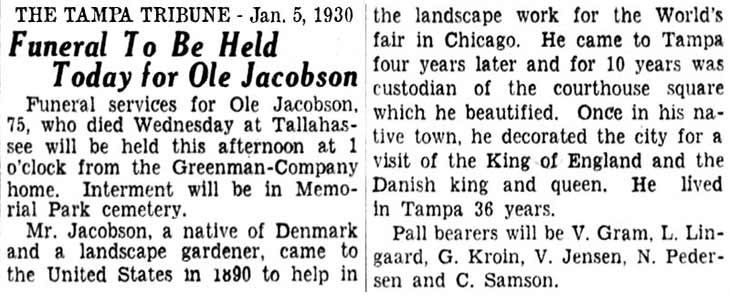 DEATH
OF OLE JACOBSEN DEATH
OF OLE JACOBSEN
Ole Jacobsen died on Jan. 1,
1930 while in Tallahassee,
one notice says he was 60, the others
say he was 75. The latter was also the only notice that said he died
in Tallahassee.
His
censuses indicate he would have been 78. It's not
known why he was in Tallahassee, or even if he actually was. Only one article says this
and there is nothing said about his body being brought back to
Tampa. Most death notices will indicate this when someone
passes away while visiting somewhere outside of their home town.
All signs indicate he was living in Tampa at the time. His
wife was his only survivor, and she is on the 1930 census in
Tampa listed as widowed. Her censuses show they never had
children. Ole's funeral was officiated by Rev. G.F. Snyder
of St. Paul's Lutheran Church and held at the Greenman-Company
funeral home on
Jan. 5, 1930 at 1 p.m. Pallbearers were V. Gram, L. Lingaard, G. Kroin, V. Jensen, N. Pedersen, and C. Samson.
He was buried in Tampa Memorial Park cemetery. |
|
May 2,
1930 |
ALLIGATOR
PASSES AWAY |
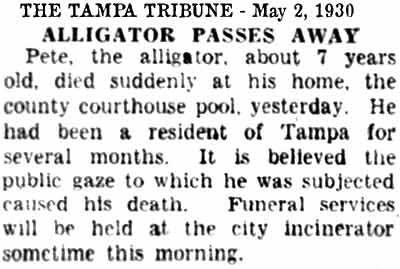
Obituary of Pete, the approximately seven year
old alligator, a resident of the courthouse pool, and
notice of his funeral services. |
|
Jul. 27, 1930 |
Letter to Tribune |
The little iron boy on the
courthouse fountain needs a bigger umbrella when the wind blows.
(In the years to come there
were several occasional letters to the newspapers and some
articles about the condition of this statue. Apparently,
the umbrella canopy was damaged or collapsing to where the water
would drain through a hole in it right onto the boys face, who
was apparently positioned looking upward. The statue was
called the "Rain-in-the-face boy.") |
|
Dec. 16, 1932 |
Alligator Antics |
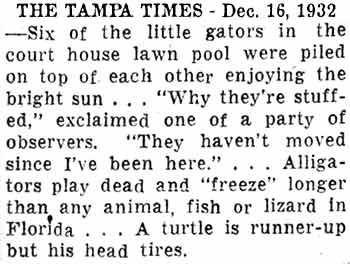
Six motionless gators prompt
one onlooker to claim that they weren't live gators, they were
stuffed. |
|
Jun. 7, 1933 |
COUNTY'S ALLIGATORS GONE
It's the end of an era for local alligator entertainment at
courthouse square. |
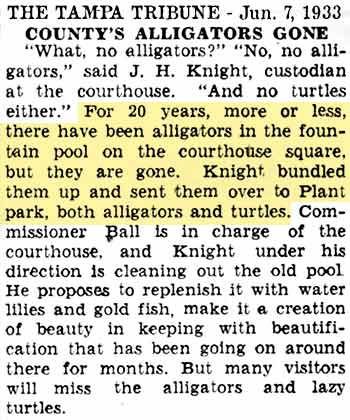 One
month short of exactly TWENTY years since the first gator
was introduced to the pool, County Commissioner Fred Ball
directed the courthouse custodian to clear out all that
inhabited the fountain basin. One
month short of exactly TWENTY years since the first gator
was introduced to the pool, County Commissioner Fred Ball
directed the courthouse custodian to clear out all that
inhabited the fountain basin.
The creatures were sent to
PLANT PARK, where the collection was just getting started,
thanks to the efforts of the County Parks Supt. Marco Penn.
The fountain pool would be
cleaned, beautified and filled with clean water, water lilies,
and goldfish. |
|
Jun. 10, 1933 |
COURTHOUSE GROUNDS ARE BEAUTIFIED IN A BIG WAY |
Work had begun to beautify the fountain and pool,
and the courthouse grounds with a fine lawn, shrubbery and
perennials having just been completed at the southwest lawn
(where the Confederate memorial stood.) The pool was
deepened, given a coat of silver aluminum paint, as well as the
fountain painted with alternating silver and gold paint.
"A bottom layer of muck is to be placed in the basin, a foot or
so below the water, and golfish are to be given a home therein."
Water lilies and other plants would be added so the fountain
would a a "point of attraction such as never was afforded by the
alligators and the mossbacked snappers..." Commissioner
Fred Ball said that the garden club ladies had made the
southwest lawn so attractive, that the fountain area didn't seem
to belong before the beautification. |
|
Jun. 13, 1933 |
ON THE
GOLDFISH STANDARD |
The fountain was now "spanking
clean and bright with silver and gold paint" and was ready to be
stocked with goldfish. The pool was being prepared by
George Tomko, "who knows his water plants." The old, dirty
gator pool is described as having "held no charm" to Florida
"crackers" but it was the tourists who found more interest in
it. |
|
Jun. 15, 1933 |
Letters to the
Tribune |
A cynical Tribune reader writes to
say the removal of the "exotic alligators and tropical turtles"
from the fountain pool was probably due to goldfish being
cheaper to feed. He/She goes on to say the next step will
be to cut down the picturesque palms and plant ordinary trees
that can be seen anywhere around the country, just to make
tourists feel at home. |
|
Jun. 1, 1938 |
MARAUDING GATOR GETS THE GATE |
The mystery of missing fish solved, there was a 4-ft
long gator in the
pool. It was lassoed and hog-tied and sent to Plant Park. |
|
THE
ORNAMENTAL FOUNTAIN
This
Tribune photo from Jan. 1940 is the only one found
thus far that shows the fountain in its entirety.
The boy appears to be in the form of a cherub, which
was often used to adorn most fountains, looking up
into his umbrella.
Most of
the old courthouse photos taken by the Burgert Bros.
and Robertson & Fresh were taken from the southwest
corner of the square, emphasizing the lawn and the
Confederate monument. Elevated and ground
views of the northwest corner of the courthouse show
the area of the fountain obstructed by trees or by
the bandstand.
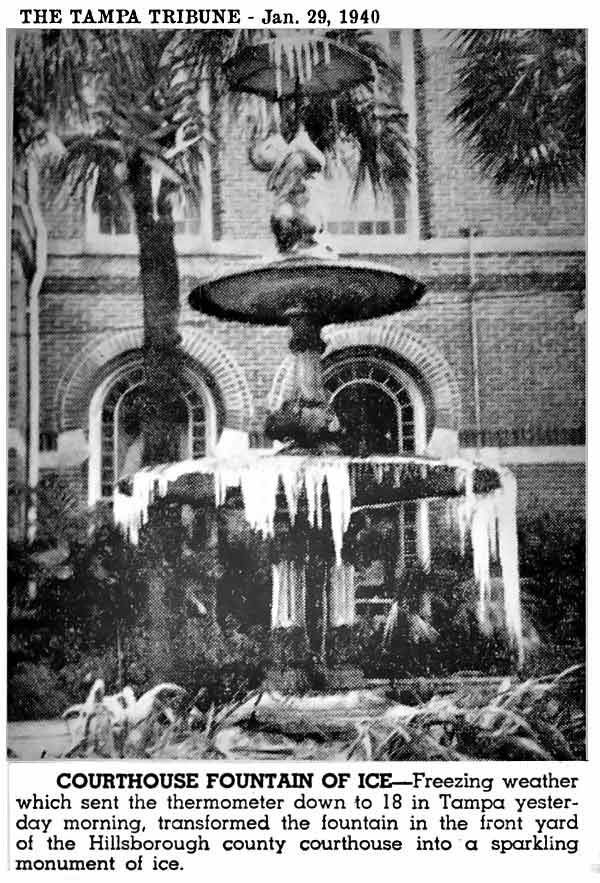
"LITTLE
RAIN-IN-THE-FACE"
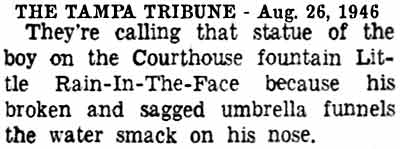
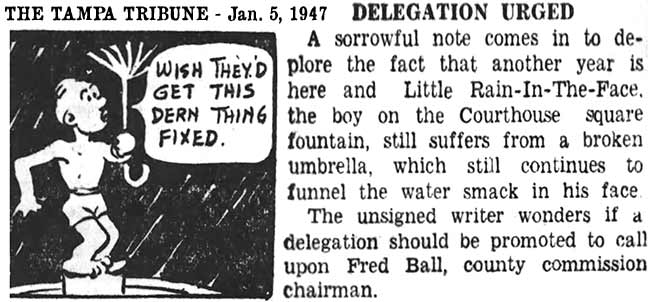 |
THE
DRINKING FOUNTAIN
When it came time to
demolish the old county courthouse in 1952, plans
were made to relocate the Confederate monument to
the new courthouse at Pierce St. The Temporary
WW1 & WW2 memorial (made of wood) was not relocated
but the plaque inside was placed in a more permanent
blockhouse-looking concrete monument (which also
serves as a tool shed for lawn equipment.)
The Woman's Christian Temperance Union had plans
with the County Commission to relocate the
drinking water fountain
at the new courthouse but only as a "monument" and
not a working fountain.
The
base of the fountain was inscribed with names of WCTU
members who originally helped in placing
the fountain at courthouse square.
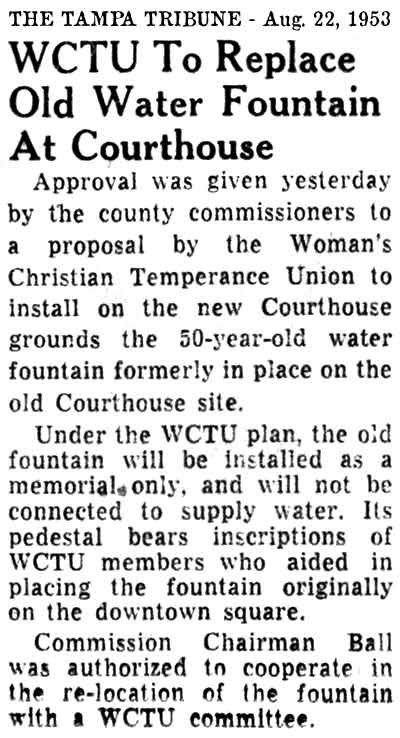
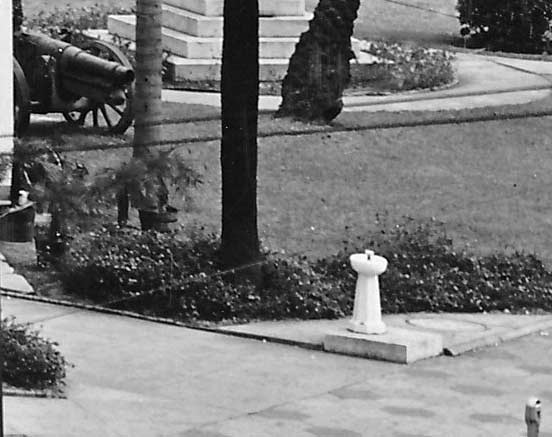
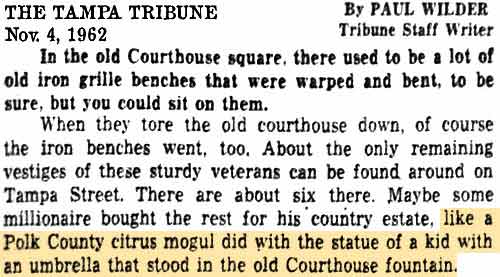
|
|
The 1962 article above right by Paul Wilder
claims that a Polk County citrus mogul bought the statue of "the kid
with the umbrella." No further research has been done to verify
this or if he bought the statue and the fountain. |
Circa 1947
Burgert Bros. photo courtesy of the Tampa Hillsborough Co.
Public Library System.
MOUSE-OVER THE
PHOTO TO SEE A CLOSE UP OF THE FOUNTAIN BASIN
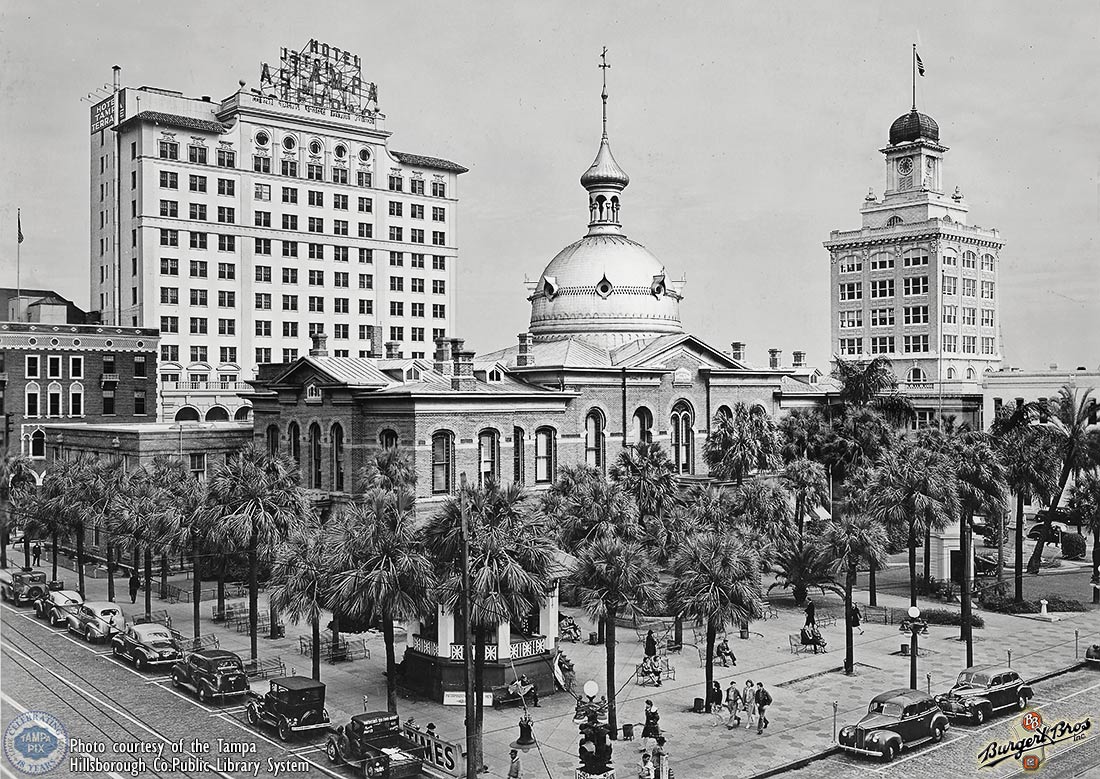
Below:
In 1948, Courthouse Square got its first exotic animal
collection--two mermaids. But seriously, this was a 1948 publicity event with Weeki
Wachee mermaids to promote a film titled "Mr. Peabody and
the Mermaid."
Part of the fountain and half of the pool can be seen at the
right edge.
MOUSE-OVER THE
PHOTO TO SEE A CLOSE UP OF THE FOUNTAIN BASIN AND MERMAIDS
Photo courtesy of Florida Memory, State Library and Archives
of Florida.
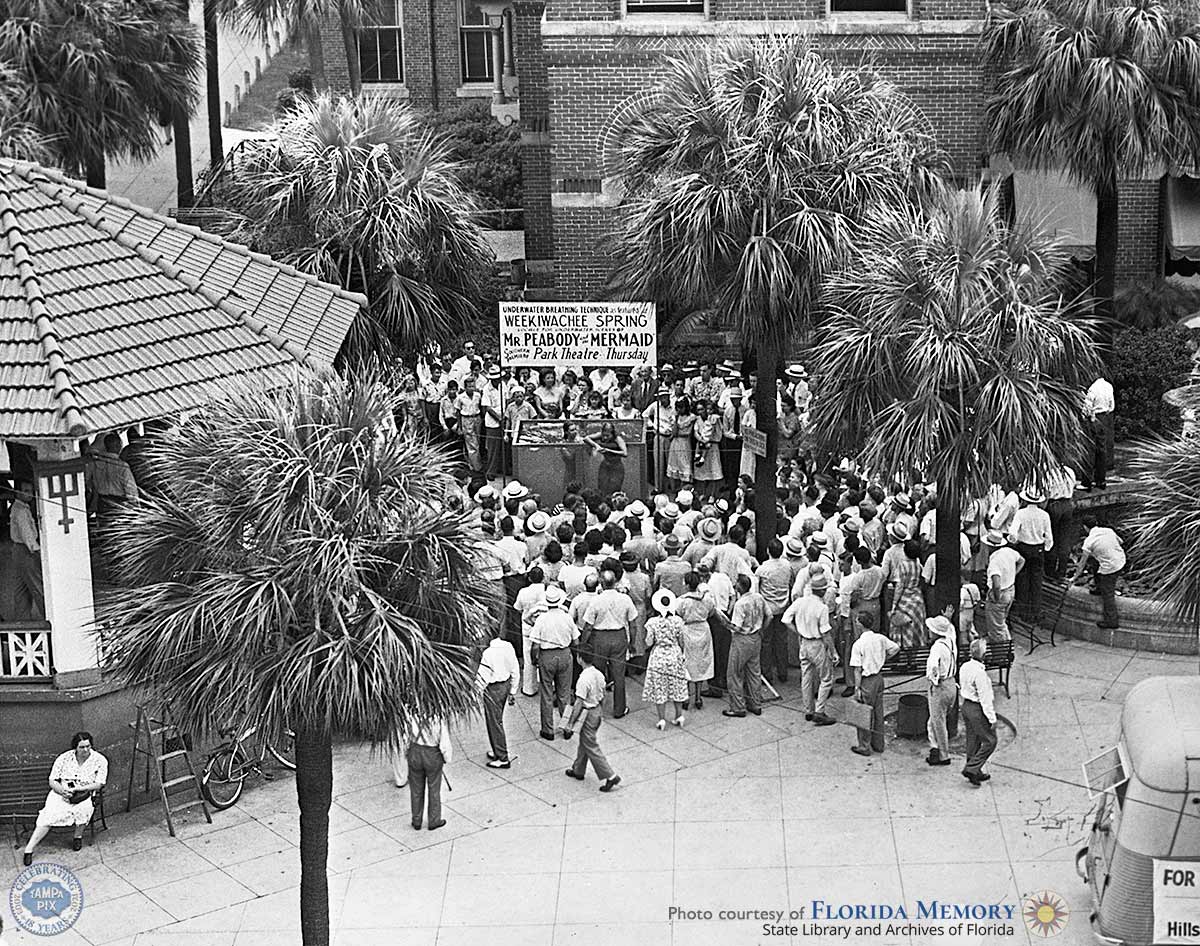
MEMORIES OF THE GATOR POOL
Tampa Tribune's "History & Heritage" by Leland Hawes
- Jan. 24 ~ Feb. 14, 1993
According to the memories of the Tribune readers who
responded below, the fountain basin was round and
about twenty five feet in diameter. A "sort of
cyclone wire covered the pool" to keep the gators
from biting people. The gators grew to about
15 to 18 inches long and grew quickly. The
wall surrounding the basin wasn't very tall; people
would sit on it.
The
photo at right was part of the article below,
submitted by Ruth L. Filkins of Winter Haven.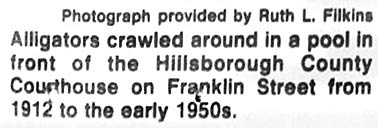 It would have been taken no later than 1933 when all
the creatures in the pool were removed and replaced
with goldfish.
It would have been taken no later than 1933 when all
the creatures in the pool were removed and replaced
with goldfish. |
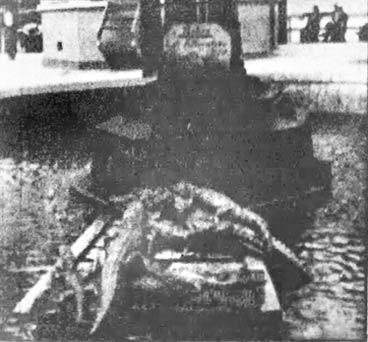 |
|
|
|
THE
ZOO AT SULPHUR SPRINGS
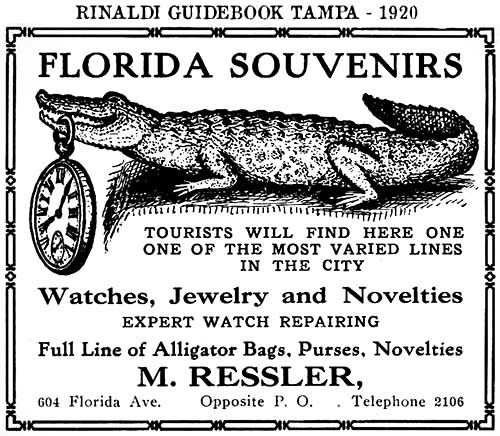 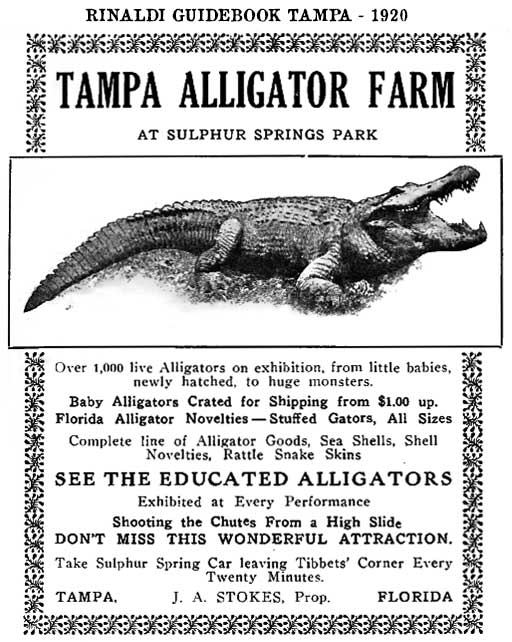 In the years when any place
with a caged animal called itself a zoo, zoos abounded in Florida, with
alligators being the main attraction. Gators were big business in
Florida; they were on display at just about every roadside citrus stand
in the state. Not only could you see them, you could buy them too. In the years when any place
with a caged animal called itself a zoo, zoos abounded in Florida, with
alligators being the main attraction. Gators were big business in
Florida; they were on display at just about every roadside citrus stand
in the state. Not only could you see them, you could buy them too.
The "zoo" at Sulphur
Springs in the 1910s to 1920s was no exception, except for the fact that C.M. Stokes had a
gator show with "educated alligators" and a "complete line of alligator
goods" as well as snakes.
From J. D. (Doug) Porter's blog, Nov. 7,
2019 "Good
size zoo for the City of Tampa."
"Snakes and Alligators Flourish at Tampa Zoo," screamed the headline.
Flourish would seem an understatement when you consider that the Sulphur
Springs zoo in Tampa, Florida was reporting the birth of thirty-four
diamondback rattlesnakes and the “setting” of two hundred alligator
eggs—in September 1914.
Lowry
Park Zoo (now ZooTampa at Lowry Park) traces its founding to 1957, but
that is not the beginning of Tampa’s zoo story—not by a long shot. That
is not even the beginning of the Lowry Park zoo part of the story.
Tampa’s colorful history with zoos began shortly after the turn of the
twentieth century. According to that September 1914 article, zoo manager
C. M. Stokes also boasted about having a “big bear”, several llamas, a
deer, some guinea pigs and birds.
Stokes claims to have handled snakes for
over 20 years, and that he "solved the ancient controversy" as to which
snakes lay eggs or give live birth. He's concluded that
non-poisonous snakes lay eggs, while poisonous ones give live birth.
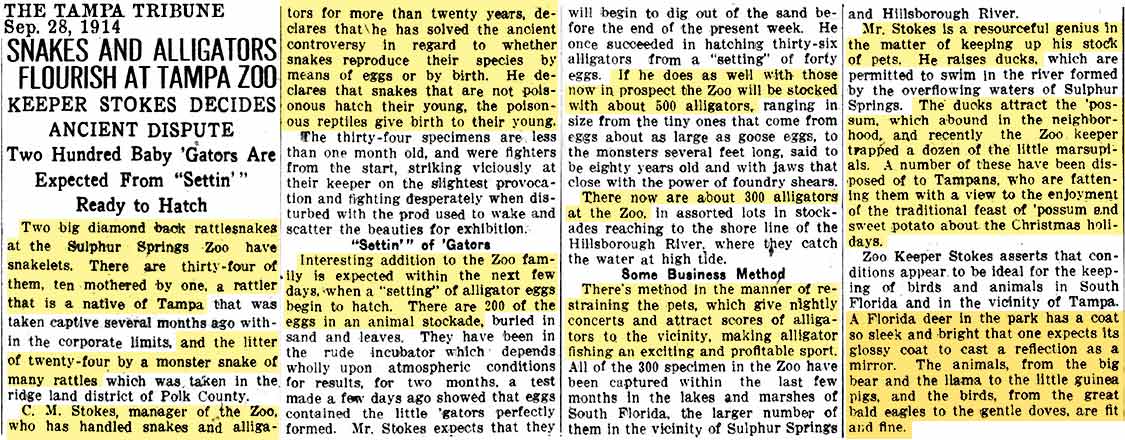
Handling snakes for over 20 years didn't
make Stokes much of an expert on them, because his "solution to the
ancient mystery" is oversimplified at best.
Hopefully, he didn't use this as a guide for handling them.
See
Which Snakes Lay Eggs, and Which Give Birth to Live Young?
by Brandon Cornett.
STOKES WANTS HIS ZOO MOVED TO PLANT PARK
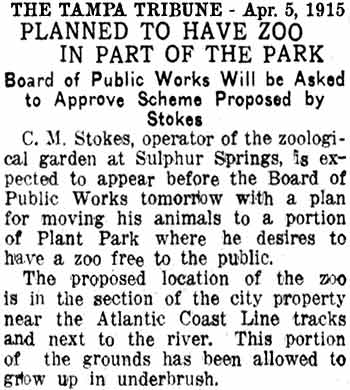
In April 1915, Stokes asked the
City’s Board of Public Works to move his animals downtown
to Plant Park and open a free zoo. The Board appointed
Commissioner Clarkson to visit the zoo and estimate the worth of the
animals. The result would depend largely on the report of
Clarkson.
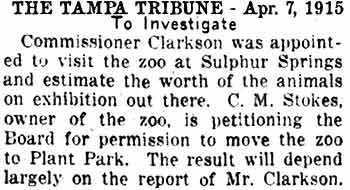
Mrs. Metcalfe, who was a promoter of
educational work for children, urged the BPW to take Mr. Stokes' offer
of moving his zoo to Park, for the education of school children and
entertainment of visitors.
But Mr. Stokes' plan involved more than
just moving his animals and starting a free zoo. He wanted the
privilege of operating a restaurant and a post card stand at the park.
Also, he apparently expected the City to buy his animals, as
Commissioner Clarkson's written report of his findings stated he did not
think the city was in a position to buy the animals because Mr. Stokes'
valuation was high, but he did agree the exhibit would be welcomed by
the public. He also thought the variety of animals was
insufficient to be worthy of the city.
Commissioner Henry Snow agreed that Tampa
should have a "creditable zoological garden" but the city could not do
so this year as there was no appropriation in the current budget for
this purpose. (At this time, old City Hall built in 1890 had just
been demolished, the new police headquarters had been built, and
construction was starting on the new City Hall in place of the old one,
all at the cost of just under $300,000.)
A new budget would be made up in June and
the matter further considered. Commissioner Henderson also favored
such an attraction, and the use of a small island at the foot of Plant
Ave. to be used as a public park and playground.

Apparently, enthusiasm for
the zoo faded as there was no further discussion about it published from
June to the end of the year. The BPW was kept busy with other
matters such as the construction of the new City Hall.
But Stokes' alligator farm
at Sulphur Springs continued to thrive well into the 1920s. The
area would become Tampa's most popular tourist attraction and recreation
site when Josiah Richardson built an amusement empire there. See
more about Sulphur Springs at TampaPix.
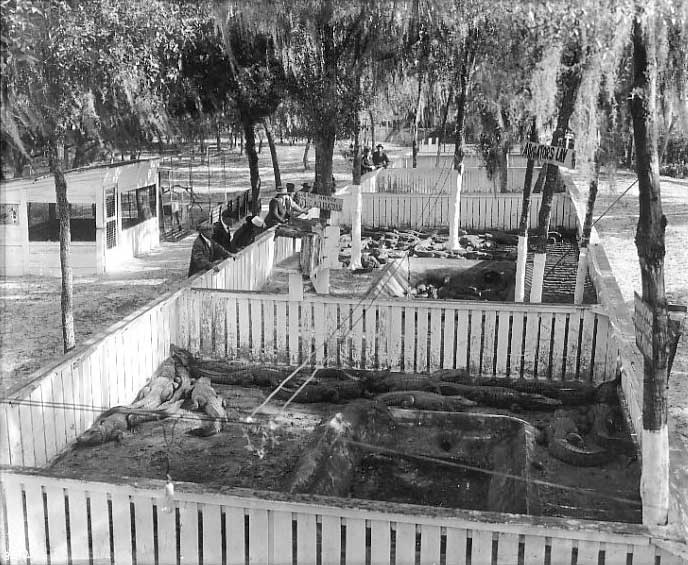
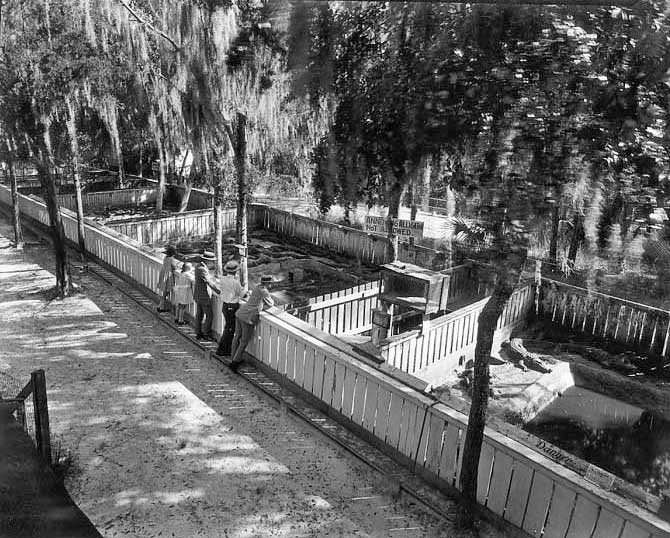
Burgert Bros. photos
above and below are courtesy of the
TAMPA-HILLSBOROUGH CO. PUBLIC LIBRARY SYSTEM.
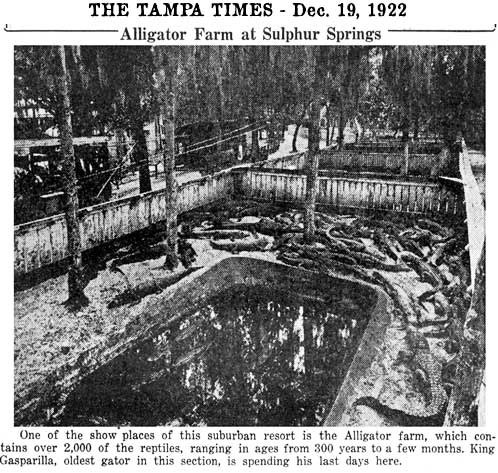
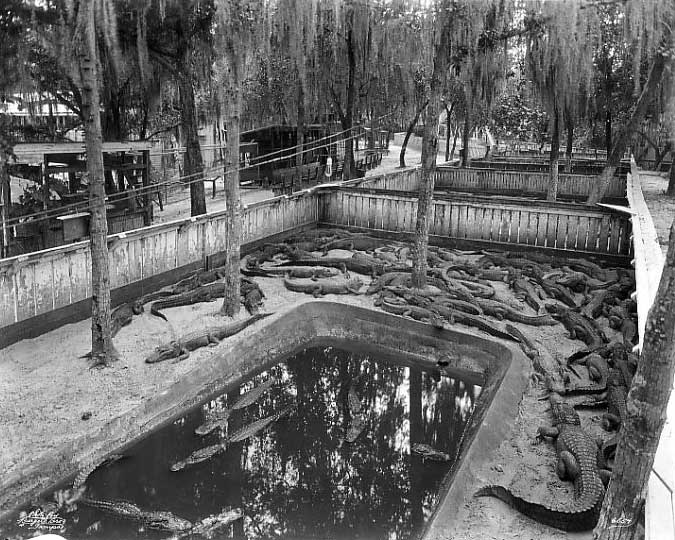
When the Great Depression hit
Tampa, many of these gators lost their jobs and were forced
to sacrifice their dignity and swallow their pride to take
dead-end jobs around the bay area. Some were more
successful than others and managed to start a career.
Others were not so lucky.
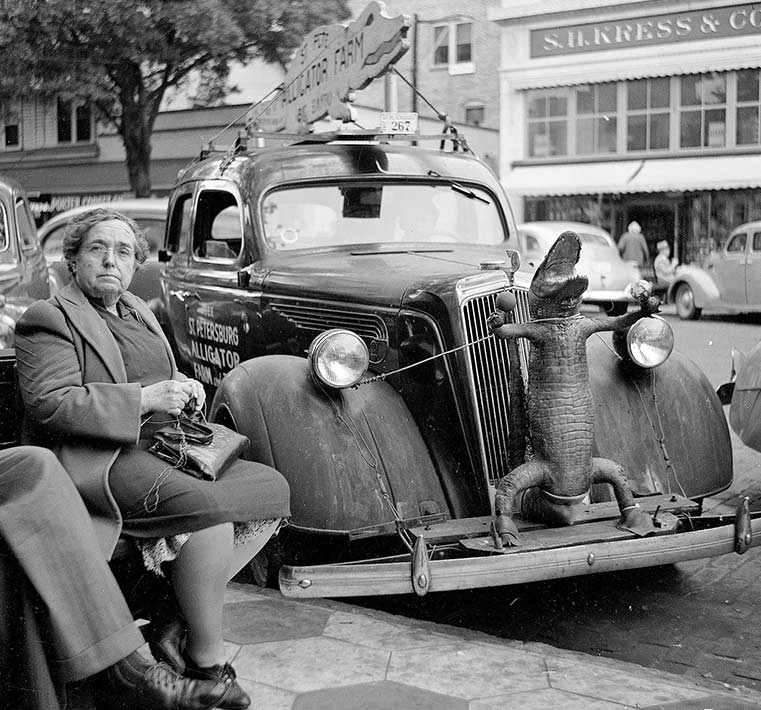
From the Walker Evans Archive at the Metropolitan Museum of
Art "125
Views of West Coast of Florida, Including: Women on
Benches in Sarasota, Mangroves, Pelicans, Shuffleboard
Players, Men on Street in Tampa, Sponge Diving Wharves at
Tarpon Springs, Coastal Residences, Fishermen, and
Miscellaneous Street Scenes" Walker Evans (American, St.
Louis, Missouri 1903–1975 New Haven, Connecticut)
Learn more about Sulphur Springs and see many photos of Josiah
Richardson's amusement park "Tourist Mecca" here at TampaPix.
|



 A
design for the fountain was selected and ordered and together with the base
they would
cost about $1,000.
A
design for the fountain was selected and ordered and together with the base
they would
cost about $1,000.
.jpg)
 as
there are other instances of "Chicago" written on the manifest
and they are very different. The handwriting sample at
right shows the writer consistently makes a capital "I" in
Illinois. The lower case "a" is almost always open at the
top, making it look like a "u." The capital "S" always
looks like an "L" and appears many times in "Sweden."
Compare to the record below and their destination appears to have been Sabula, Iowa, a
town located on an island in the Mississippi River between
Illinois and Iowa, about 100 mi. west of Chicago.
as
there are other instances of "Chicago" written on the manifest
and they are very different. The handwriting sample at
right shows the writer consistently makes a capital "I" in
Illinois. The lower case "a" is almost always open at the
top, making it look like a "u." The capital "S" always
looks like an "L" and appears many times in "Sweden."
Compare to the record below and their destination appears to have been Sabula, Iowa, a
town located on an island in the Mississippi River between
Illinois and Iowa, about 100 mi. west of Chicago.

 DEATH
OF OLE JACOBSEN
DEATH
OF OLE JACOBSEN

 One
month short of exactly TWENTY years since the first gator
was introduced to the pool, County Commissioner Fred Ball
directed the courthouse custodian to clear out all that
inhabited the fountain basin.
One
month short of exactly TWENTY years since the first gator
was introduced to the pool, County Commissioner Fred Ball
directed the courthouse custodian to clear out all that
inhabited the fountain basin.







 It would have been taken no later than 1933 when all
the creatures in the pool were removed and replaced
with goldfish.
It would have been taken no later than 1933 when all
the creatures in the pool were removed and replaced
with goldfish.
